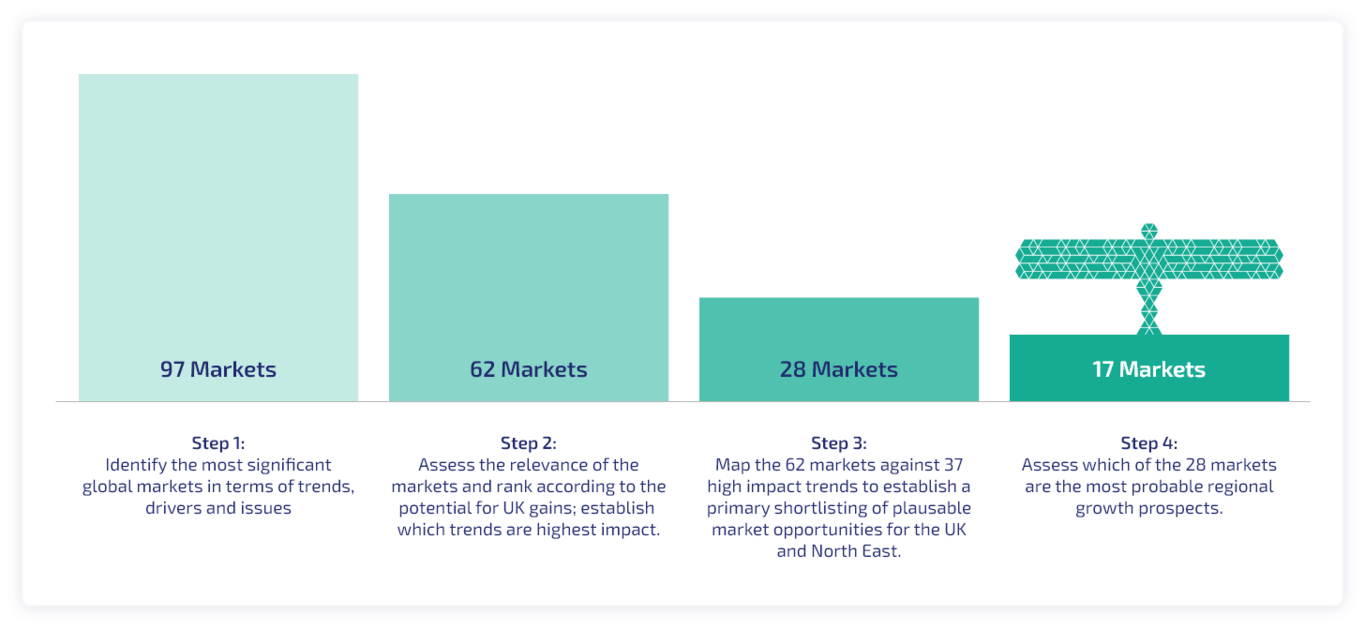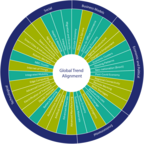About this project
The aim of this project was to analyse a range of global trends, issues and growth drivers and situate their impact in a North East context. In doing so the project identified 17 markets that are likely to present opportunities for regional growth in the North East over the next 10-15 years.
The first stage of analysis was to identify a long list of 97 global markets that are likely to be affected by the continued development of global trends. This horizon scanning process was undertaken independently by Frost and Sullivan using their BEETS framework, a key tool for foresight analysis on which more detail is provided below.  The next stage was to narrow these markets and trends to those that are most relevant in the UK context. Trends were narrowed to those that are ‘high impact’ due to the convergence of several trends operating in the same direction. The markets were narrowed down to 62 on the basis that these markets are likely to present opportunities for growth in the UK. After placing these markets in the UK context, the next stage was to cross reference these markets and the high impact trends alongside wider economic and social aims in the North East. This led to a shortlist of 28 markets to be assessed in the North East context.
The next stage was to narrow these markets and trends to those that are most relevant in the UK context. Trends were narrowed to those that are ‘high impact’ due to the convergence of several trends operating in the same direction. The markets were narrowed down to 62 on the basis that these markets are likely to present opportunities for growth in the UK. After placing these markets in the UK context, the next stage was to cross reference these markets and the high impact trends alongside wider economic and social aims in the North East. This led to a shortlist of 28 markets to be assessed in the North East context.
Finally, Cambridge Econometrics assessed the North East LEP’s strengths and position in these 28 markets to identify a final 17 markets that present the most probable prospects for regional growth. This review triangulated data from a variety of sources, including analyses of literature and regional assets, data from ONS sources and innovative data sources such as the Data City. This last data source was especially important because many of these markets do not map straightforwardly to standard industrial classification codes. Further information on the Data City methodology is available below.
These final 17 markets have been developed into the 16 market profiles accessible above (autonomous and electric vehicles were condensed into one profile due to their overlap). These describe the global prospects for each market, the regional assets available in the North East, the current position of the market in the North East and the strategic opportunities available for the region.



















 The next stage was to narrow these markets and trends to those that are most relevant in the UK context. Trends were narrowed to those that are ‘high impact’ due to the convergence of several trends operating in the same direction. The markets were narrowed down to 62 on the basis that these markets are likely to present opportunities for growth in the UK. After placing these markets in the UK context, the next stage was to cross reference these markets and the high impact trends alongside wider economic and social aims in the North East. This led to a shortlist of 28 markets to be assessed in the North East context.
The next stage was to narrow these markets and trends to those that are most relevant in the UK context. Trends were narrowed to those that are ‘high impact’ due to the convergence of several trends operating in the same direction. The markets were narrowed down to 62 on the basis that these markets are likely to present opportunities for growth in the UK. After placing these markets in the UK context, the next stage was to cross reference these markets and the high impact trends alongside wider economic and social aims in the North East. This led to a shortlist of 28 markets to be assessed in the North East context.





